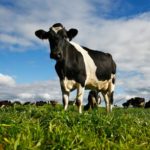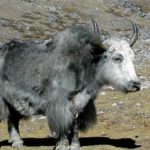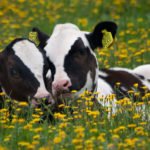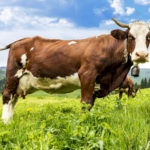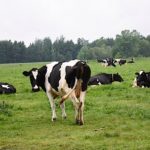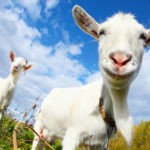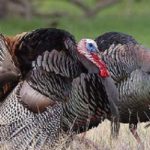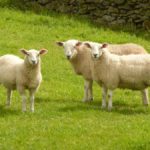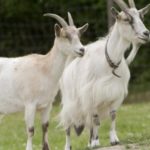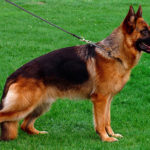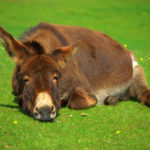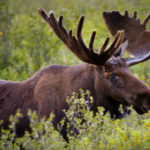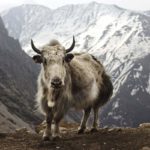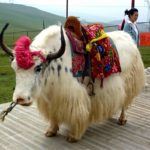Cows
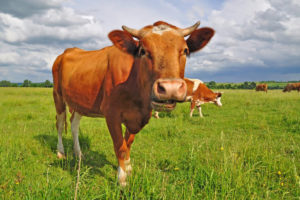 The cow belongs to the order of cloven-hoofed, the family of the half-breed. The size and weight of the cow depends on the breed. For example, the height of the Breton cow from hooves to withers does not exceed 1.2 m. The height of other rocks may exceed 1.5 m.
The cow belongs to the order of cloven-hoofed, the family of the half-breed. The size and weight of the cow depends on the breed. For example, the height of the Breton cow from hooves to withers does not exceed 1.2 m. The height of other rocks may exceed 1.5 m.
Some breeds are focused on milk production, others – meat. Still others give meat with milk, and serve as draft power. In Europe today, you can hardly see a bull drawn in a wagon or a plow. But in the third world, bulls still play an important role. Meat cows (those that are grown for meat) usually have more impressive sizes than dairy cows. The cow weighs an average of 400 kg. (The weight of a male cow, bull, can exceed 1600 kg.) Cows of dairy breeds usually have thin legs and a narrow neck and head. Examples of good dairy breeds can be Guernsey and Frisian.
Life expectancy is about 30 years. Sexual maturation occurs by 2-3 years. After 9 months of pregnancy, the cow usually gives birth to one, sometimes two calves. Dairy cows can give litter as early as the 17th month of life. Young cows are usually called calves.
The cow is a herbivore ruminant. In the winter it is fed with grain crops, beet and corn. In summer, it eats more than 50 kg of grass a day. The cow needs 1.4 kg of dry food daily – hay, silage, grass – for 45 kg of body weight. Cows of dairy breeds require additional feed – 1.8 kg daily for every 4 liters of milk given. Mineral additives are necessary. Stone salt and water must be available at all times.
This animal belongs to cattle. In home farming, it is extremely popular all over the world. Thanks to the cow, people were able to enjoy such dairy products as milk, cottage cheese, sour cream, etc. The cow can give up to 20 thousand liters of milk per year.
The amount of milk received from a cow, directly depends on how much it drinks. On the day she should drink at least 60 liters. water. The cow udder has only 4 nipples, and she can give 4 large buckets of milk a day. A cow must be born every year. Milk the cow 2-3 times a day. Manual milking is a simple process that can be easily trained. These animals were domesticated a long time ago, several thousand years ago. They derive their origin from wild tours. This wild bull lived in meadows and in deciduous forests of Europe and Asia. Since the XVII century, he completely disappeared.
Cows have a very good hearing and musical memory. So, they can be taught to return from the pasture home for a certain sound or song. Even the quality of milk is influenced by musical accompaniment. The scientists found that those cows who were allowed to listen to the music they liked, the quality of milk was much higher than their neighbors, who grazed without musical accompaniment.
But their sight and sense of smell are very poorly developed. People have long noticed that the cow is often frightened when it suddenly comes too close to it. The fact is that, thanks to a special device of the eyes, the cow sees everything on an enlarged scale. Cows are almost unable to distinguish colors. The taste is very thin, almost like a person. They give off sweet food, they will not eat bitter.
The cow digests food in a peculiar way. Her stomach consists of 4 chambers. In the pasture, she quickly swallows the grass without chewing it. After, on vacation, she quietly regurgitates small portions of herbs and slowly grinds her teeth. Now the food is ready for digestion and gets into the back chambers of the stomach. In a complex stomach, the herb is digested by the action of bacteria that destroy plant cells and gastric juice.
Cows are found all over the Earth. Domestic cows can be divided into two large groups – some have a high, like a hump, withers, others do not. Humpbacked cows are called zebu. They are distributed in South and South-East Asia, they were brought to South America and Africa. They bred and without humpback cows, as on other continents.

